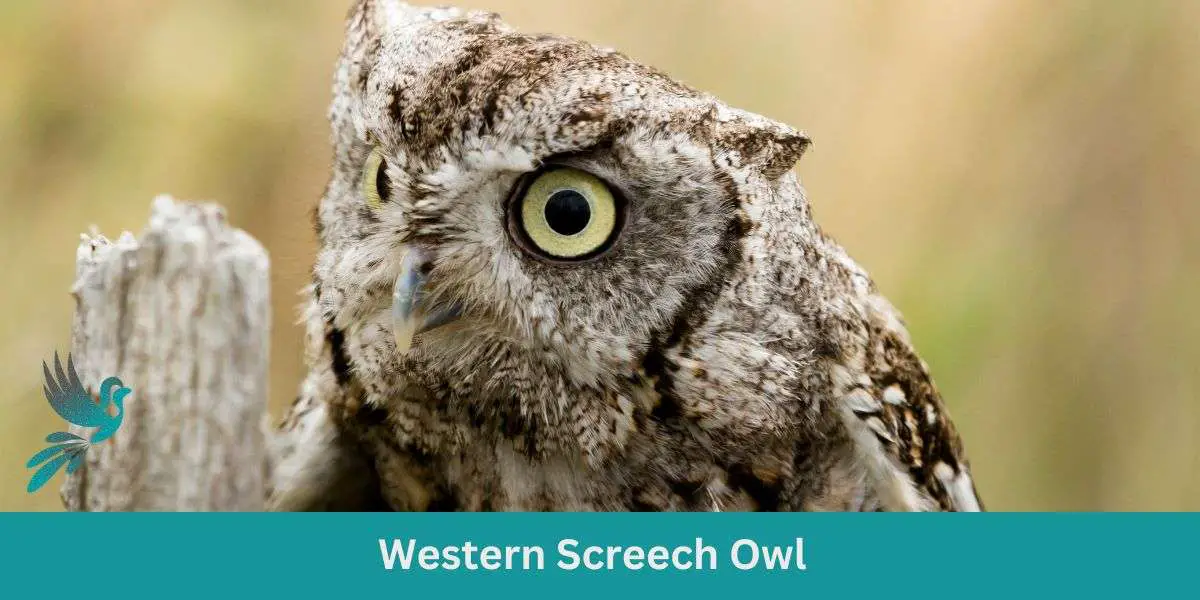The Western Screech Owl, a compact raptor with large yellow eyes and a distinctive voice, is a captivating creature of the nocturnal world. Though not as commonly recognized as its larger owl relatives, it holds a unique niche in North America’s ecosystems.
Dive with us into the realm of this enigmatic bird as we explore its habits, habitat, and the harmonious calls that punctuate the night.
Description
- Physical Appearance: Standing at about 8-9 inches tall, this owl has a rounded head without ear tufts. Its cryptic plumage—gray or brown with complex patterns—offers perfect camouflage against tree barks.
- Distinctive Calls: Its “screech” is more of a series of whistles and soft trills than an actual screech. These calls help in territorial establishment and mate communication.
The Western Screech-Owl is a small owl species with a distinctive appearance. It measures around 8 to 10 inches in length and has a wingspan of 19 to 24 inches. This owl has a stocky build with a rounded head that lacks ear tufts. I
ts plumage varies in color, ranging from gray to brown, with intricate patterns that provide excellent camouflage in its woodland habitats. This owl has large, yellow eyes that give it a wise and mysterious look.
The Western Screech-Owl possesses unique physical characteristics that contribute to its survival. Its coloration and intricate patterns of gray or brown feathers help it to blend seamlessly into its woodland surroundings.
The owl’s compact size, rounded head, and lack of ear tufts distinguish it from other owl species. Its large, yellow eyes are keen and provide excellent visibility in low-light conditions. These owls have sharp talons and a sharp beak, enabling them to catch their prey efficiently.
Habitat
- Geographical Range: Predominantly found in the western parts of North America, from Alaska down to Central Mexico.
- Preferred Habitats: Woodlands, riparian forests, suburban areas, and even city parks.
The Western Screech-Owl is a highly adaptable species that can be found in a variety of wooded or semi-open habitats. It prefers areas such as forest edges, wooded suburbs, canyons, mesquite groves, and saguaros in the desert, as well as streamside groves in arid regions.
It mostly inhabits deciduous or mixed woods, avoiding extreme desert environments and higher elevations in mountains. They are often found in suburban areas and are known to nest in tree cavities, poles, giant cacti, and old woodpecker holes.
This species of owl can be found throughout western North America, from southeastern Alaska down to the Arizona desert. It has a wide distribution, but its population has declined in some areas due to habitat loss. While the Western Screech-Owl is a resident bird in its range, it may undertake short-distance migrations in search of suitable habitats or prey.
Feeding Behavior
Like its eastern counterpart, it has a varied diet.
The Western Screech-Owl is primarily a nocturnal hunter, foraging at dusk and throughout the night. It hunts by perching and watching for prey, then swoops down to capture it on the ground or from foliage.
- Insects:
- A major component of their diet, especially during the warmer months.
- They prey on beetles, moths, crickets, and other insects.
- Small Mammals:
- Prey includes mice, shrews, voles, and occasionally small bats.
- Birds:
- They can prey on smaller birds, often those that are active during the nighttime or around dawn or dusk.
- Reptiles and Amphibians:
- They consume a variety of species, including small snakes, lizards, and frogs.
- Invertebrates:
- Beyond insects, their diet might include spiders, centipedes, and worms.
- Occasional Prey:
- Western Screech Owls have been known to hunt for fish or crayfish in shallow waters on rare occasions.
- Hunting Technique:
- Like the Eastern Screech Owl, the Western variety is a perch-and-pounce predator, often sitting and waiting for prey to become visible or audible and then swooping down to capture it.
- Feeding Behavior:
- Smaller prey is typically swallowed whole, while larger prey is torn into manageable pieces.
- Indigestible parts, like fur, feathers, and bones, are regurgitated as pellets.
The owl’s diet varies based on its habitat and region but consists mainly of small mammals and large insects. It feeds on beetles, moths, spiders, scorpions, centipedes, small birds, lizards, snakes, frogs, and fish. The owl can locate its prey using both sight and sound, making it a proficient hunter.
Reproduction
- Nesting Sites: Natural tree cavities, woodpecker holes, or nest boxes provided by humans.
- Offspring: Typically lay 2-6 eggs, with both parents involved in raising the young, from incubation to feeding.
The Western Screech-Owl’s breeding season typically occurs from March to July. During courtship, the male displays bowing behavior, clicks its bill, and brings food to the female. Mated pairs engage in preening each other’s feathers and calling in duets.
The owl nests in cavities, such as old woodpecker holes, natural hollows in trees, or even old magpie nests. The female incubates the 2 to 5 (sometimes 6) white eggs for about 26 days, while the male brings food to her.
Once hatched, both parents provide food for the young. The chicks leave the nest approximately four weeks after hatching and receive parental care for some time thereafter.
Conservation Status
The Western Screech-Owl is considered a widespread and common species, but its population has declined in certain areas due to habitat loss. It faces threats from deforestation, urbanization, and the destruction of nesting sites.
The International Union for Conservation of Nature (IUCN) has listed this species as a species of least concern. However, continued conservation efforts are essential to ensure the long-term survival of this remarkable owl.


Leave a Reply
You must be logged in to post a comment.